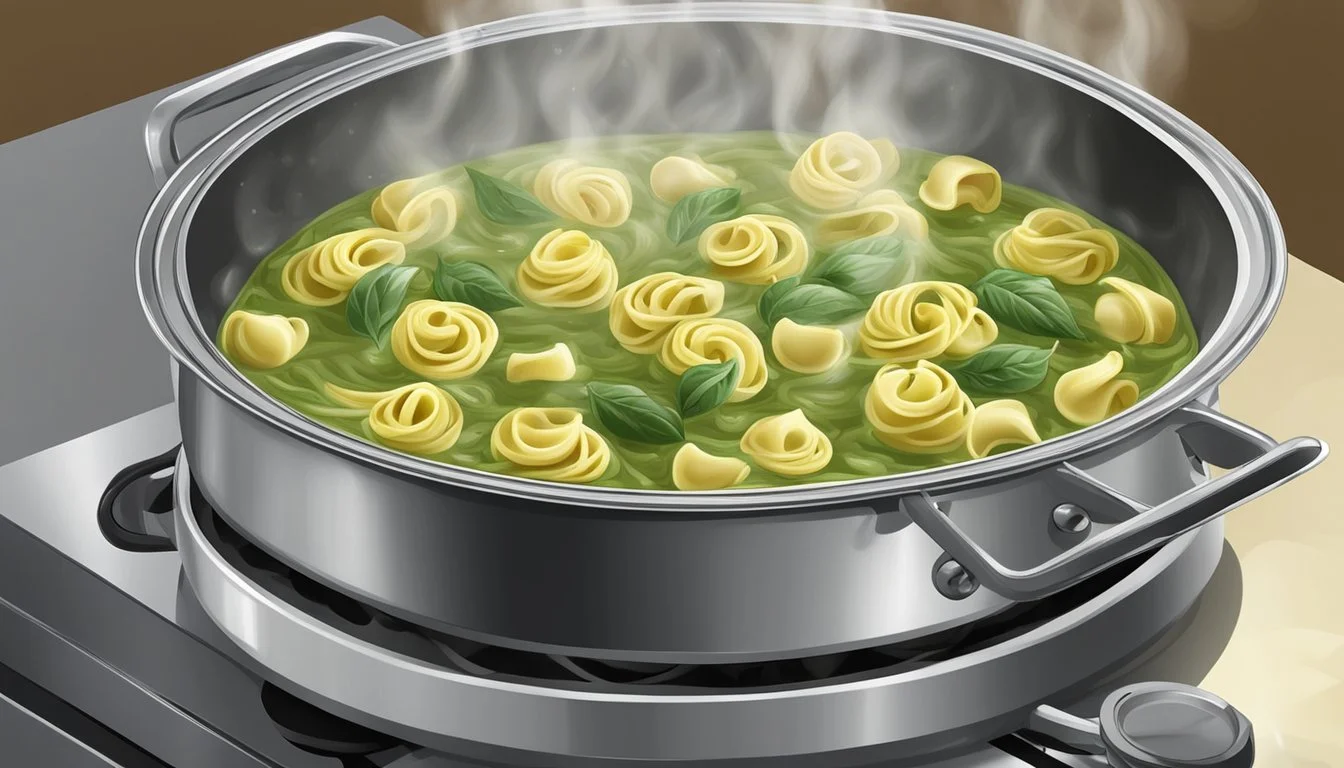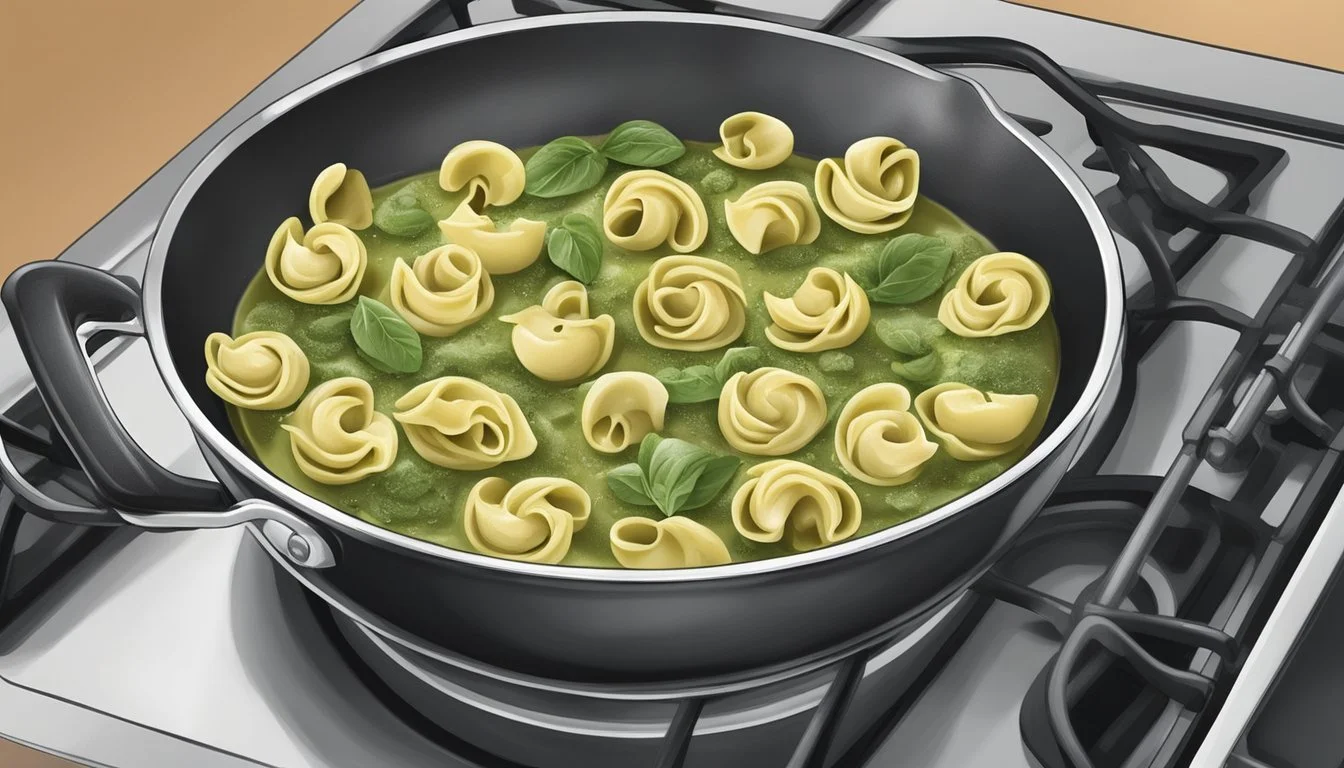Best Way to Reheat Tortellini with Pesto
Ensuring Tender Pasta and Vibrant Flavor
Reheating leftover pasta (What wine goes well with pasta?), particularly tortellini topped with pesto, can be tricky. The aim is to restore the pasta to its tender best while maintaining the vibrant flavors of the pesto sauce. Tortellini, with its delicate filling, can easily become overcooked, and pesto can lose its freshness when exposed to too much heat. However, with the right technique, one can achieve that just-cooked taste and texture which makes the dish so appealing in the first place.
The guide to reheating tortellini with pesto involves gentle heating and a touch of moisture to revive the pasta without diminishing its quality. To lock in the succulence of the tortellini and the aromatic essence of the pesto, it's important to avoid methods that could lead to sogginess or separation of the oil in the pesto.
The best ways to reheat pasta of this variety center on methods that evenly distribute heat while safeguarding the pasta's structure and the sauce's flavor profile. It’s essential to understand how different reheating methods can affect the outcome, and to have knowledge of those methods that work harmoniously with the delicate composition of tortellini with pesto.
Understanding Tortellini Reheating Fundamentals
When reheating tortellini, especially with pesto, preserving the tender texture of the pasta and the full flavor of the pesto is essential. The process requires a careful balance of temperature control and technique to ensure a desirable outcome.
Pasta and Pesto Characteristics
Tortellini is a type of pasta that often contains a filling and is shaped into a ring. Its texture should remain tender yet firm to the bite, a characteristic known as "al dente." Pesto, a sauce traditionally made with basil, garlic, pine nuts, Parmesan cheese, and olive oil, is delicate and can lose its vibrant color and flavor if overheated.
Key points about pasta and pesto:
Tortellini texture: should be al dente post-reheat.
Pesto flavor: sensitive to high temperatures which can diminish its vibrancy and taste.
Reheating Challenges
The main challenge in reheating tortellini with pesto is to maintain moisture and texture while bringing the dish to a comfortable temperature. Ensuring even heat without causing the pasta to turn mushy or the pesto to become oily and separated is crucial.
Parameters for successful reheating:
Temperature: Warm through without reaching a point that alters texture or taste.
Texture: Preserve the filling's tenderness and pasta's firmness.
Moisture: Prevent drying out which can happen quickly, especially in microwave reheating.
Taste: Keep the pesto's flavor profile as close to its original state as possible.
Recommendations for reheating involve gradual heating using mediums that do not strip the pasta of moisture or cause the pesto to overheat.
Preparation Before Reheating
Before diving into reheating techniques, understanding how to store and set up tortellini with pesto is essential. Proper preparation ensures the pasta remains tender and the pesto keeps its vibrant flavor when reheated.
Storing Leftovers Properly
For optimal results, pesto tortellini leftovers should be stored in an airtight container in the refrigerator. Placing a piece of parchment paper directly on the surface of the pesto can help prevent oxidation and color change. Aluminum foil is not ideal for storing pesto pasta as it can react with the pesto and alter the flavor. Leftovers should be consumed within three to four days.
Setting Up for Reheating
When setting up for reheating, one should consider the method that will be used to ensure the pesto sauce does not separate and the pasta remains tender.
For the oven, preheat it to 350 degrees Fahrenheit. Transfer the pasta to an oven-safe dish, lightly coat with olive oil or a small amount of pesto to prevent drying out, and cover with foil.
For the microwave, transfer the pasta to a microwave-safe dish, adding a few teaspoons of water to prevent dryness. Cover the dish with a microwave-safe lid or a piece of vented cling film.
Regardless of the chosen method, allow the tortellini to reach room temperature for even heating, which minimizes the risk of it becoming tough or the sauce becoming oily.
Reheating Techniques Overview
When reheating tortellini with pesto, choosing the right technique is crucial to preserve the pasta’s tenderness and maintain the pesto's rich flavor.
Oven Reheating Method
Preheat your oven to 350 degrees Fahrenheit for a consistent heating environment. Place the tortellini in an oven-safe baking dish, adding a sprinkle of water or additional pesto to introduce moisture. Cover the dish with aluminum foil to trap the steam and reheat for about 20 minutes, ensuring the pasta stays moist and flavors are locked in.
Microwave Reheating Strategy
For a quick reheat, use a microwave-safe dish and cover the tortellini with a damp paper towel to maintain moisture. Microwave on medium power in 30-second intervals, stirring in between to distribute heat evenly. This method helps retain the pasta's moisture while reviving the pesto's vibrant flavors.
Stovetop Methods Explained
One can also reheat tortellini on the stovetop using a skillet. Gently warm the pasta over medium heat, adding a bit of sauce, broth, or olive oil to keep it from drying out. Stir continuously for even heating. This sautéing method effectively rejuvenates the pasta and pesto without compromising texture or taste.
Innovative Reheating Methods
For those seeking alternative reheating techniques, an air fryer or toaster oven set at 350 degrees Fahrenheit can offer a quick fix. Spray the tortellini with oil before heating to avoid sticking. In contrast, slow cookers and grills are generally not recommended for reheating pasta dishes due to uneven heat distribution and the risk of overcooking.
Maintaining Taste and Texture
When reheating tortellini with pesto, the key challenge is to warm the dish thoroughly while preserving the delicate balance of its flavors and the tender texture of the pasta. It's essential to employ techniques that prevent the tortellini from becoming too dry or the pesto from losing its vibrant taste.
Avoiding Overcooking
To prevent the tortellini from becoming tough and losing its tender quality, one should reheat it carefully:
Microwave: Heat in medium, one-minute intervals, stirring between each, until the desired temperature is reached.
Oven: Warm the tortellini covered with aluminum foil at 350°F for about 20 minutes.
Stovetop: Use a non-stick skillet on medium heat, stirring occasionally, for 5-7 minutes.
Remember to test for warmth without allowing the pasta to overheat and become rubbery.
Enhancing Flavor After Reheating
Retaining and enhancing the flavor of the pesto and the cheese in tortellini after reheating requires a few simple steps:
Add Moisture: A couple of teaspoons of water or olive oil can help to maintain the pasta's moisture.
Use Fat: A bit of olive oil or butter can not only add moisture but also enhance the overall flavor profile of the pesto and complement the cheese.
Final Touches: After reheating, finish with a sprinkle of fresh Parmesan to reinvigorate the flavor and add a taste dimension.
Safety and Health Considerations
When reheating tortellini with pesto, it is crucial to maintain both safety and health standards to ensure the meal is enjoyable and safe to eat. Here are the considerations one must keep in mind:
Temperature: One should reheat the tortellini to an internal temperature of 165°F to eliminate any potential food-borne bacteria. The use of a food thermometer is advisable to check this.
Refrigeration: Leftovers should be stored in the refrigerator within two hours of cooking and consumed within three to four days. Refrigerated tortellini should be reheated only once as repeated temperature changes can increase the risk of food poisoning.
Direct Heat: Avoid using high direct heat as it can unevenly reheat the pasta, potentially causing some parts to be overcooked and others still cold. Gentle reheating methods are preferable.
Healthier Methods:
Steaming: Retains the moisture and prevents the pasta from drying out.
Microwave: Use a microwave-safe cover to trap steam and ensure even heating.
Oven: Cover with foil to prevent drying and bake at a moderate temperature.
One must also consider the pesto's delicate nature, which includes fresh ingredients like basil and garlic that can deteriorate if reheated improperly.
Finally, it is important that the reheating method does not compromise the nutritional integrity of the meal, keeping it as close to its original, freshly-cooked state as possible. Reheating should be carried out in a way that maintains the tortellini's tenderness and the pesto's flavorful, herby qualities.
Additional Tips and Tricks
When rehydrating tortellini with pesto, the objective is to maintain tenderness in the pasta and vibrancy in the pesto flavor. These tips will help achieve the best results.
Choosing the Right Reheating Method for Pesto
Oven Reheating: For gentle and even heating, baking in the oven is advisable. One can cover the tortellini and pesto in an oven-safe dish with foil and warm it at a moderate temperature, such as 350 degrees Fahrenheit, to avoid drying out.
Stovetop Reheating: A non-stick skillet is perfect for a quick warm-up. The key is to heat the pesto just enough to blend the flavors without causing the basil and garlic to lose their punch.
Rehydration Tip: Adding a splash of water or extra sauce can prevent the pasta from drying out and help retain the creamy texture of the pesto.
Serving Suggestions and Pairings
Garnishing: Adding fresh basil leaves atop the reheated dish can enhance the aroma and bring a fresh taste to the forefront.
Cheese: A sprinkle of high-quality Parmesan right before serving ensures that it melds properly without overwhelming the pesto.
Spices: For a subtle enhancement, a pinch of spices that complement basil and garlic, such as black pepper, could be added after reheating.






